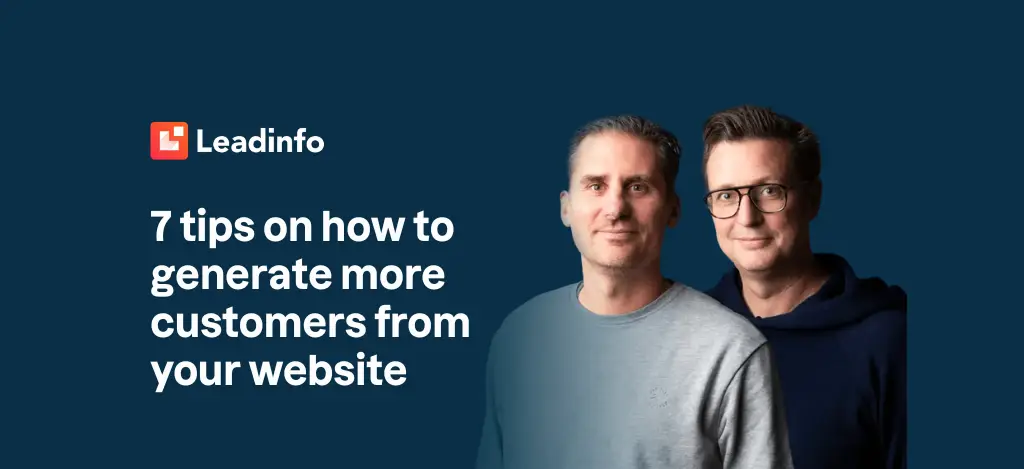Every entrepreneur dreams of having a website that generates customers. Yet, 98 percent of visitors still leave a site without leaving a trace. In the webinar “Time for Your Website to Deliver Customers”, Johan and Christof from the Belgian agency Hannibal showed how to break this pattern. They combined their DAAG model with the data power of Leadinfo and shared a wealth of practical examples. In this article, we summarise this insightful webinar into 7 concrete tips you can put into practice straight away!
Would you like to rewatch the webinar? You can do so here. The webinar is recorded in Dutch, but you can use the subtitle feature to transcribe the webinar to English or other languages.
Why aim for a website that generates customers?
A website is often the first point of contact with a potential customer. If that contact moment does not convince, the prospect disappears from view for good. You should therefore see your website as the engine of your marketing and sales activities.
A website that generates customers:
- converts anonymous visitors into qualified leads;
- shortens the sales cycle because prospects come in warm;
- provides data that enables you to allocate your marketing budget more effectively.
In other words: your site should not only inform, it should persuade and activate.
The DAAG model: your quick quality scan
In the webinar, Johan and Christof introduced the DAAG model. It is a simple yet effective method to evaluate whether your site is already optimised for turning visitors into customers. The DAAG model consists of four pillars:
1. Clear
A visitor decides within three seconds whether to stay. Make sure it is immediately clear who you are, what you offer, and what next step you expect. Think powerful headings, concise paragraphs, and one prominent call-to-action. Carefully consider what you want the visitor to do.
- Use scannable headings and short sentences.
- Always place your primary CTA in view, without the visitor having to scroll.
2. Accessible
You can only attract customers if they can find you. A quick keyword analysis reveals within minutes which terms your target audience uses. Then, optimise titles and meta descriptions, and launch targeted Google ads to increase visibility.
- Focus on long-tail keywords (search terms with 3+ words) with high purchase intent.
- Combine organic traffic with search campaigns on platforms such as Google Ads or Microsoft Ads.
3. Attractive
Design evokes emotion. A clean layout with plenty of white space, clear typography, and micro-animations keeps attention. Don’t forget to apply the “banana” method. This means making your most important call-to-action button stand out from your brand colours, so visitors don’t have to search for it. Use contrasting colours, such as orange and blue. These are easy for people to spot. You can find contrasting colours in the colour wheel. Take the colour opposite your chosen colour and use it for your call-to-actions.

- Conduct design tests with your target audience to see what does and doesn’t work.
- Fix your most important action in your navigation bar.
4. Credible
Social proof is crucial for conversion. Show recent reviews, customer logos, and relevant certifications such as ISO or awards won. Automate review requests so you build a constant flow of new testimonials using automation tools such as Autopilot.
- Request reviews automatically to strengthen your social proof.
- Place reviews near your most important call-to-action.
Use Leadinfo to convert anonymous traffic into tangible leads
Even a perfectly DAAG-optimised site remains dependent on data. That’s why Hannibal chose Leadinfo in their strategy. Leadinfo identifies business visitors via their IP address and links this information to company profiles, LinkedIn contacts, and CRM fields. This way, you not only know that someone is showing interest, but also which company is showing interest.
A few practical examples from the webinar
- A SaaS company exports the list of recognised companies weekly and launches hyper-targeted LinkedIn remarketing.
- An industrial supplier sees in Leadinfo that a prospect visited the pricing page three times and calls the right person within a day.
- An e-commerce player uses heatmaps and screen recordings to remove UX frictions, increasing the checkout ratio by 11 per cent.
Would you also like to see which companies are interested in your products or services? Try Leadinfo free for 14 days, no strings attached. Create your account here.
Seven golden tips to turn your website into a sales machine
- Squint your eyes at your homepage. Do the CTAs stand out? If not, use the banana method.
- Create a separate page for each service you offer with a long-tail title, optimised for findability.
- Optimise titles around the phrase “website that generates customers” or relevant variations for your business.
- Start Google Search campaigns with the same long-tail keywords to build both an organic (long-term) and paid (short-term) strategy.
- Place Leadinfo’s tracking code before other scripts for extra accuracy.
- Export Leadinfo data and upload it as a list with company data in LinkedIn Ads to set up an account-based marketing campaign.
- Automate review requests to continuously collect social proof.
Start your journey today towards a website that generates customers
A website that generates customers does not happen by accident. By consistently applying the DAAG model, cleverly using UX psychology, and leveraging Leadinfo data, your site becomes an indispensable part of your sales process. Start with a quick DAAG scan, implement at least one optimisation per category, and measure the results with Leadinfo. Step by step, you will build a website that not only attracts visitors, but more importantly, wins new customers.


